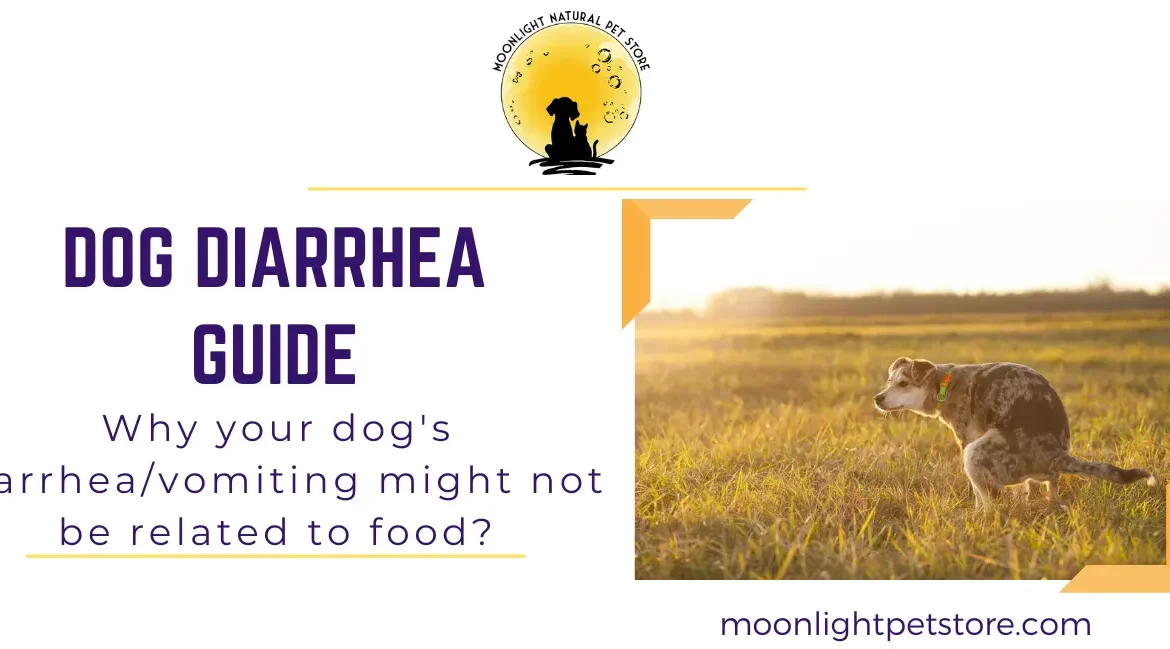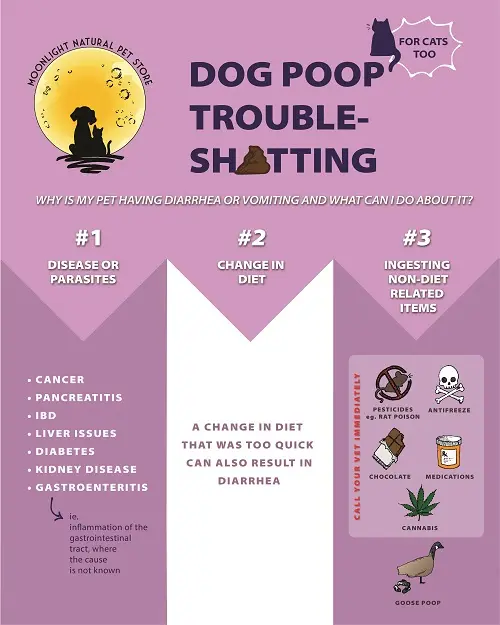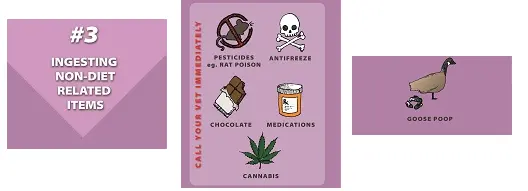
How To Fix Dog Diarrhea Fast: Causes, Effective Home Remedies & When To See A Vet
Diarrhea in dogs is one of the most common problems pet parents face. Knowing how to assess your dog’s symptoms, what home remedies actually work, and when vet care is needed can save you stress, money, and possibly your dog’s life.
This updated guide combines:
- Fast at-home assessment
- Effective natural remedies
- Danger signs you can’t ignore
- Common causes of dog diarrhea—including those often overlooked like goose poop
- Research-based prevention tips
Quick Assessment: When Is Dog Diarrhea Serious?
Before using any home remedy, spend 10 seconds checking your dog’s stool and behaviour. This determines whether home care is appropriate—or whether you need emergency vet care.
Red-Flag Signs (Stop Reading & See a Vet Immediately):
- Black, tarry stool (possible internal bleeding)
- Large amounts of fresh blood
- Diarrhea + repeated vomiting
- Lethargy, collapse, pale gums
- Your dog refuses water
- Suspected ingestion of rat poison, antifreeze, chocolate, cannabis, or medication
If any apply → GO TO EMERGENCY VET NOW.
Mild Diarrhea (Home Remedies Are Usually Fine):
Your dog is:
- Acting normal, drinking and eating
- Having loose or soft stool
- Possibly small streaks of fresh blood/mucus
Common mild causes:
- Eating something weird
- Sudden diet change
- Stress/boarding
- Giardia exposure
- Mild bacterial imbalance
Dog Troubleshitting Guide: Why Your Dog’s Diarrhea Isn’t Always About Food
It’s tempting to blame diet changes for diarrhea, but many factors play a role. In reality, environmental pathogens, parasites, and non-food ingestion often play a bigger role.
Across Canada (especially BC), we see seasonal bursts in diarrhea cases as:
- Giardia rises in puddles and parks
- Geese migrate and shed contaminated feces
- Dogs eat more outdoor debris in spring/fall
When diet changes don’t fix the diarrhea, vets frequently find:
- Giardia
- E. coli
- Salmonella
- Foreign-object ingestion
This is why our core approach is always:
Poop, Scoop and Test
Take a stool sample—even if you don’t have an appointment. It saves time, money, and helps your vet diagnose correctly.
For the checklist, skip directly to the Dog Troubleshitting Guide section or the Infographic.
Common Causes of Dog Diarrhea

Many issues can trigger dog diarrhea, not just sensitive stomachs. Here are common triggers:
Disease or Parasites
- Inflammatory bowel disease (IBD), pancreatitis, liver/kidney conditions, cancer. In some cases, if the cause is unknown, it is labeled as gastroenteritis, which is basically inflammation of the gastrointestinal tract.
- Intestinal parasites: giardia, hookworms, roundworms, protozoa
Pet Food Diet-Related Causes
- Sudden switch to new food format or a new protein diet that was too quick could also result in diarrhea.
- Overfeeding, fatty foods, or low-quality ingredients
Read Method 2 of transitioning from kibble to raw dog food, as some of those are still appropriate for any diet change.
Ingesting Non-Food Items (Often Missed)
Dogs explore with their mouths faster than humans can react.
- Common household items could cause your pet to have diarrhea e.g. Garbage, foreign objects, toxins (pesticide, antifreeze, medications)
- Goose poop/ feces is surprisingly common in spring–fall, carrying pathogens (Salmonella, E. coli)
How Non-Food Items Affect Your Dog’s Digestive Health:
CALL YOUR VET if you think your dog or cat has eaten or swallowed any of the top 5 following:
- Pesticides (e.g., rat poison) are now made quite palatable for rats to eat but can also entice dogs or cats. Vomiting and diarrhea are symptoms, and this is a vet emergency. Pesticides are typically used in Fall, when it is getting colder, and rats are more likely to move indoors. BC has temporarily banned the use of rodenticide although restaurants and grocery stores are part of the exempt groups.
- Antifreeze – ethylene glycol is toxic in dogs. It can take as little as licking a few drops for a dog to get a lethal dose. Again, this is a vet emergency. Make sure to clean up your garage if brake fluid leaks from your car or motorbike. A lot of people sometimes store a secondary car/ convertible until the weather gets warm. Prevent your dog from drinking from places where antifreeze is added to prevent toilet pipes from freezing.
- Chocolate has theobromine and caffeine, which are slowly absorbed by dogs. These can cause vomiting and diarrhea depending on how much your dog ate, the type of chocolate and how big your dog is. Call your vet to ask for directions on what to do. Chocolate is a problem during and after the Christmas holidays, Valentine’s Day, and Halloween.
- Medications – call your vet immediately.
- Cannabis can cause your dog to vomit excessively and drool. I added Cannabis to this list as it is now legal in Canada and lots of vets are seeing dog’s showing cannabis poisoning. The cannabis poisoning can be from the second-hand smoke or your dog/ cat ingesting edibles or cannabis directly. This is quite serious so please take your dog or cat in to the vet if they are drooling/ lethargic/ restless, and/or having ataxia (difficulty controlling movement).
- Goose poop –could lead to vomiting and diarrhea.

You will likely have heard of the first 5 items as they are quite well-documented. However, from Spring till Fall, we find that goose poop is usually implicated though not widely known for causing diarrhea and/or vomiting in dogs. These tend to result in chronic diarrhea in dogs.
Goose Poop: The “Hidden” Cause of Dog Diarrhea in Canada
Dog owners do not typically consider goose poop as the cause of their dog diarrhea or vomiting. Usually, dog owners consider their dog eating goose poop as a gross but harmless activity.
However, goose poop can contain salmonella, virulent strains of E-coli, Campylobacter – Helicobacter & Clostridium botulinum. All of these are bacterial infections causing gastrointestinal issues. In addition, goose poop can have giardia.
Study Example (Peer-Reviewed):
A study using a One Health approach (The World Health Organization is a proponent of One Health Initiative) “analysed E. coli in Canada geese in the USA, found that more than 95% of their isolates (n = 47) was resistant to a variety of antibiotic substances, such as ampicillin, cephalothin, and sulfathiazole.”1
This is particularly important as vets may treat dog diarrhea underlying cause by prescribing Metronidazole (Flagyl) and when that does not clear the illness switch to fenbendazole (Panacur) or vice versa in the treatment of giardia.
If your dog ate goose poop and develops diarrhea, take a sample of your dog’s poop to the vet. Request an ELISA test for giardia not a fecal float, which might miss the cysts. They may also test for salmonella and e.coli. See our blog on Salmonella, E-Coli, Giardia for more information on symptoms and how these issues are treated.
Dog Troubleshitting Guide: What You Should Do (Fast)
Our Dog Troubleshitting (all puns intended) is a step-by-step checklist for suspected diarrhea for unsuspecting pet parents. Note that we are not vets and are providing this guide to help you talk to your vet.
Step 1: Check for Red Flags (See a Vet Immediately):
- Blood in stool (dark “tarry”)
- Frequent vomiting + diarrhea
- Lethargy, weakness, collapse
- Dehydration signs (sunken eyes, dry gums)
- Known ingestion of poison / toxin / foreign object
If yes → Emergency vet.
Step 2: Gather Vet-Helpful Information
- When did the diarrhea start? Any concurrent symptoms?
- Disease or parasites– Does your dog/ cat have any diagnosed illnesses? Y/ N
- pancreatitis, cancer, IBS, Liver or kidney disease, Diabetes, other?
- Ingesting Non-Food Item – Did your dog or cat ingest any goose/cat/dog poop, sticks, human medicine, cooked bone or drink from a puddle etc. ? Y/ N
- If IN DOUBT about what it ingested and your dog/ cat is not acting normal, call your vet!
- If any of the above is answered YES:
- Collect a fresh stool sample (Poop, Scoop and Test).
- If ingestion is suspected, don’t induce vomiting unless directed
- List current medications, vaccinations, deworming history if any
- Call your vet asap to book diagnostic testing- bloodwork, urinalysis or sometimes ultrasounds.
Step 3: Start Home Remedies (ONLY if mild pet diarrhea & no red flags)
- Change in diet – have you changed your dog or cat’s diet recently? Y/ N
- If yes, what did the dog/ cat eat?
- Was it a slow transition to the new food? (Read method 2 of slow transition here.)
- If it was a slow transition, has your pet tried that particular protein in the past?
- Cat Vomiting – Is your cat long-haired and does it groom incessantly?
- Dog Vomiting – how often is it happening. If there were chunks of pet food and it happens only after eating. Your dog may have eaten too fast (if vomit happened quickly ~<2 hrs?).
- Is it a short-snout/ dog e.g., French bulldog/ Frenchie, Pug? Discuss soft palate issues with your vet.
- If yes, what did the dog/ cat eat?
See below for each home remedy step if this is only related to Change in Diet.
6 Effective Home Remedies to Stop Dog Diarrhea (Research-based)
Once you’ve ruled out medical emergencies using the Dog Troubleshitting Checklist, you can begin safe, natural home care—especially if the diarrhea is mild and your dog is otherwise acting normal.
Below are evidence-supported remedies used by integrative vets, top pet nutritionists, and leading veterinary sources (Merck Vet Manual, CDC, ACVIM).
Important: If diarrhea lasts longer than 48–72 hours, or your dog shows ANY red-flag symptoms, seek veterinary care.
1. Rest Your Pet’s GI Tract. (Short Fasting Window)
For healthy adult dogs (not puppies, seniors, small breeds, or diabetic pets):
- Withhold food for 8–12 hours to let the gut calm down.
- Always provide fresh water or electrolyte broth (unseasoned).
Why it works:
Short periods of gut rest reduce intestinal contractions and irritation.
Avoid fasting for:
- Puppies
- Toy/small breeds
- Diabetic pets
- Dogs prone to hypoglycemia
(If unsure → skip fasting and go directly to bland foods.)
2. Feed a Low-Fat, Bland Diet for 24–72 Hours
Instead of the outdated “rice + ground beef/ turkey” (which often causes gassiness due to rice fermentation)—use these options:
Better Bland Food Options
- Pureed pumpkin (including skin + seeds) – whole-food fiber to bulk up stool
- Bone broth – hydrates, soothes, provides amino acids for gut repair
- Plain kefir or fermented goat milk – provides probiotics + B vitamins
- Boiled turkey or chicken breast + mashed squash
Holistic option:
- Pumpkin + bone broth + shredded turkey = gentle, hydrating, gut-friendly.
Feed small, frequent portions:
- 2–3 tablespoons for small dogs
- ¼ to ½ cup for larger dogs
Repeat every 3–4 hours.
If diarrhea improves → transition back to normal food over 1–2 days.
3. Rehydrate & Let Pet Rest
Diarrhea pulls water and electrolytes from your dog’s body. Dehydration can trigger nausea in pets. In serious situations of dehydration, please visit the vet for IV fluids.
If note severe, use:
- Bone broth
- Electrolyte solutions formulated for pets
- Fresh water at all times
Avoid: Human sports drinks (too much sugar & sodium).
Signs of dehydration: dry gums, sunken eyes, thick saliva → vet visit..
Let the cat or dog sleep so that they can recover.
4. Use Slippery Elm (Excellent for Acute Diarrhea)
Use slippery elm to stop dog intestinal diarrhea. It helps firm stool and soothe inflammation.
About ¼ tsp of powder for every 10 lbs mixed in bland food or water. Honest Kitchen Perfect Form contains slippery elm.
5. Consider Dog/ Cat Probiotics (Especially After Antibiotics or Dietary Upset)
Probiotics help restore the gut microbiome, especially when diarrhea is caused by:
- Stress
- Sudden food change
- After taking antibiotics
- Giardia treatment
Choose:
- Multi-strain dog-specific probiotics
- S. boulardii, which is widely researched for acute diarrhea relief
Give for 7–14 days.
6. Support Vomiting Issues
- Cat Vomiting– Sometimes cats who groom constantly tend to vomit frequently. The hairball could be lodged in your cat’s system so that whenever it eats, it ends up throwing up. You may sometimes find a hairball or not. Try using Vet’s Best Hairball Relief to resolve this vomiting. It contains slippery elm.
- Dog Vomiting – Is it a short-snout/ brachycephalic dog e.g., French bulldog/ Frenchie, Pug? Elevate your pet food and prevent the dog from playing directly after eating.
Should you change your pet’s diet to veterinary diets dog food?
For humans, doctor’s don’t put people with diarrhea on a new diet. You just eat bland and nourishing foods. Same with pets.

Preventing Salmonella, E. coli, and Giardia Infections in Pets
Why does the FDA have a zero-tolerance policy against salmonella in pet food? The FDA made this change as preventing salmonella is more about ensuring that humans that live with pets do not get sick.
There is already knowledge that dogs and cats may tend to carry salmonella already. They are also able to deal with some loads of salmonella or E. coli infection without being symptomatic.
Prevention Tips: Stop Dog Diarrhea Before It Starts
- Stop your dog from eating goose/ dog/ cat poop/ feces
- Buy your dog a muzzle if it is quicker at eating items outside than you can prevent it.
- Avoid puddles, ponds or drinking from outside standing water. This is especially important for puppies!
- Use a portable dog bottle.
- Wipe your dog’s mouth after meals with a dedicated face towel that is frequently washed.
- Use dog wipes to clean their paws/ wash the paws when you get home.
- Wash your dog/ cat bowl for food and water daily.
- Practice good hygiene.
- Pick up dog poop with a poop bag without holes in it.
- Wash your hands after picking dog poop,
- Wash hands after handling pet food (kibble and raw alike) as well as treats.
- Clean and disinfect after any vomiting/diarrhea episode
Conclusion
This guide is meant to help you identify patterns, recognize emergencies early, and provide better information to your vet so they can diagnose accurately. They are not meant to replace Vet advise.
If you’re ever unsure whether your dog’s diarrhea is an emergency:
Follow the Quick Assessment Checklist and contact your veterinarian.
Authoritative References
- Potential disease transmission from wild geese and swans to livestock, poultry and humans: a review of the scientific literature from a One Health perspective. by Johan Elmberg, Charlotte Berg, Henrik Lerner, Jonas Waldenström, and Rebecca Hessel https://www.ncbi.nlm.nih.gov/pmc/articles/PMC5443079/
- Salmonellosis in Animals by Walter Grünberg , DVM, PhD, DECAR, DECBHM, Faculty of Veterinary Medicine, Justus-Liebig-Universität Giessen, Giessen, Germany. Last full review/revision Aug 2020 https://www.merckvetmanual.com/digestive-system/salmonellosis/salmonellosis-in-animals?query=salmonella
- Raw Meat Diet transcript from Dr. Karen Becker https://karlaspets.com/wp-content/uploads/2016/03/Dr-Becker-Raw-Diet-Article.pdf
- E.coli infection
- Effectiveness of Fenbendazole and Metronidazole Against Giardia Infection in Dogs Monitored for 50-Days in Home-Conditions https://www.ncbi.nlm.nih.gov/pmc/articles/PMC8032893/
- Survey of Canada goose feces for presence of Giardia https://faculty.cnr.ncsu.edu/christophersdeperno/wp-content/uploads/sites/8/2016/01/PR91-GiardiainGeeseHWI.pdf
- Giardiasis https://www.cfsph.iastate.edu/Factsheets/pdfs/giardiasis.pdf
- CDC Giardia and Pets https://www.cdc.gov/parasites/giardia/prevention-control-pets.html
- Giardiasis http://www.merckvetmanual.com/digestive-system/giardiasis-giardia/overview-of-giardiasis


